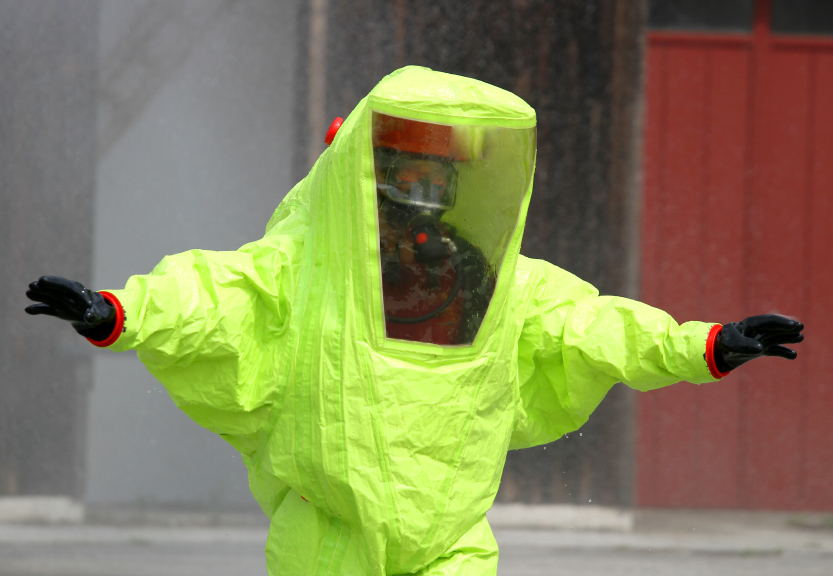
|
On the Level
The number of decontamination stations needed will depend on the level of protection required. For personal protective equipment (PPE) there are three levels of protection that would require decontamination stations. Level A applies when the greatest level of skin, respiratory, and eye protection is required. Level B applies when the highest level of respiratory protection is required, but a lesser level of skin protection is needed. Level C applies when the concentration and type of airborne contaminant is known and the criteria for using air purifying respirators are met.
The maximum decontamination procedures for all levels consist of specific activities at 19 stations. Each station emphasizes an important aspect of decontamination. The sequence of the stations is known as the “decontamination line.”
HAZWOPER Training Program. You won’t find a more thorough and effective course related to hazardous waste operations to help meet the employee training requirements of OSHA’s HAZWOPER regulation (29CFR 1910.120). Learn More!
Stop at Each Station
The following stations are those required for maximum protection for Level A.
|
Station |
Measure |
Procedures |
|
1 |
Segregated Equipment Drop |
Deposit equipment used on site (tools, sampling devices and containers, monitoring instruments, radios, clipboards, etc.) on plastic drop cloths or in different containers with plastic liners. During hot weather operations, a cool-down station may be set up within this area. |
|
2 |
Boot Cover and Glove Wash |
Scrub outer boot covers and gloves with decontamination solution or detergent/water. |
|
3 |
Boot Cover and Glove Rinse |
Rinse off decontamination solution from Station 2 using copious amounts of water. |
|
4 |
Tape Removal |
Remove tape around boots and gloves, and deposit in container with plastic liner. |
|
5 |
Boot Cover Removal |
Remove boot covers and deposit in container with plastic liner. |
|
6 |
Outer Glove Removal |
Remove outer gloves and deposit in container with plastic liner. |
|
7 |
Suit and Boot Wash |
Wash encapsulating suit and boots using scrub brush and decontamination solution or detergent/water. Repeat as many times as necessary. |
|
8 |
Suit and Boot Rinse |
Rinse off decontamination solution using water. Repeat as many times as necessary. |
Meet your OSHA-required 8-, 24-, or 40-hour HAZWOPER training requirements with HAZWOPER Training Program!
|
9 |
Tank Change |
If an air tank change is desired, this is the last step in the decontamination procedure. Air tank is exchanged, new outer gloves and boot covers donned, and joints taped. Worker returns to duty. |
|
10 |
Safety Boot Removal |
Remove safety boots and deposit in container with plastic liner. |
|
11 |
Fully Encapsulating Suit and Hard Hat Removal |
Fully encapsulated suit is removed with assistance of a helper and laid out on a drop cloth or hung up. Hard hat is removed. Hot weather rest station may be set up within this area for personnel returning to site. |
|
12 |
Self-Containing Breathing Apparatus (SCBA) Backpack Removal |
While still wearing face piece, remove SCBA backpack and place on table. Disconnect hose from regulator valve and proceed to next station. |
|
13 |
Inner Glove Wash |
Wash inner gloves with decontamination solution that will not harm the skin. Repeat as often as necessary. |
|
14 |
Inner Glove Rinse |
Rinse inner gloves with water. Repeat as many times as necessary. |
|
15 |
Face Piece Removal |
Remove face piece. Deposit in container with plastic liner. Avoid touching face with fingers. |
|
16 |
Inner Glove Removal |
Remove inner gloves and deposit in container with liner. |
|
17 |
Inner Clothing Removal |
Remove clothing and place in lined container. Do not wear inner clothing off-site since there is a possibility that small amounts of contaminant might have been transferred in removing the fully-encapsulating suit. |
|
18 |
Field Wash |
Shower if highly toxic skin-corrosive or skin-absorbable materials are known or suspected to be present. Wash hands and face if shower is not available. |
|
19 |
Redress |
Put on clean clothes. |
